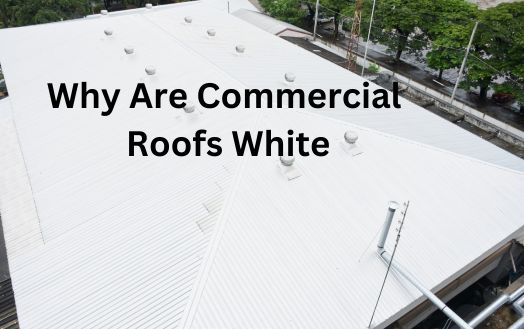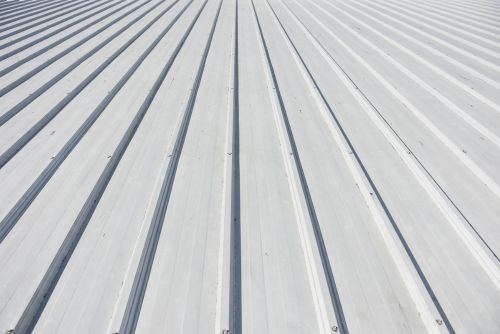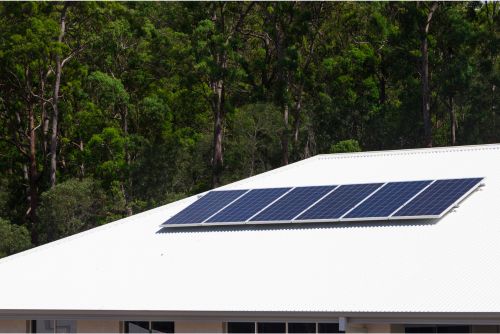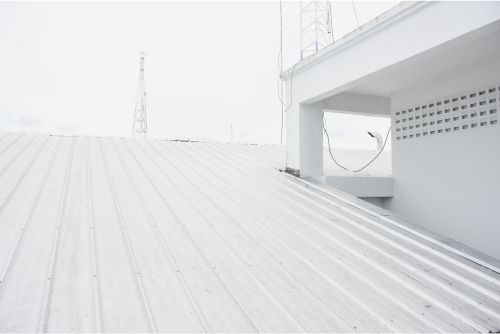
Commercial roofs play a crucial role in protecting buildings from various weather conditions, ensuring durability and structural integrity. Along with their functional purpose, commercial roofs also come in various colors, with white being a popular choice. The color of a commercial roof can have a significant impact on energy costs, environmental benefits, and overall performance. In this blog, we will explore the significance of commercial roof colors, unravel the mystery of why white roofs are so popular, discuss the pros and cons of white roofs, and explore other color options for commercial roofs. Whether you’re considering a new roof for your commercial building or simply curious about why are commercial roofs white, this blog will provide valuable insights into why commercial roofs are often white.
When it comes to commercial roofing, the color of the roof is not merely an aesthetic choice. It has a significant impact on energy costs, environmental benefits, and overall roof performance. The choice of roof color can influence how much solar energy the roof absorbs and reflects, which in turn affects the building’s heating and cooling costs. Additionally, roof color plays a role in the roof’s reflectivity, impacting energy savings. By understanding the significance of commercial roof colors, building owners can make informed decisions that align with their energy efficiency goals and environmental considerations.
The color of a commercial roof plays a crucial role in its overall performance. One of the key factors affected by roof color is thermal emittance, which refers to the roof’s ability to radiate solar energy back into the atmosphere. Lighter-colored roofs, such as white roofs, have higher thermal emittance, meaning they reflect more of the sun’s rays and absorb less heat. This, in turn, leads to lower rooftop temperatures and reduced energy costs.
Additionally, roof color affects how much solar energy the roof absorbs. Darker-colored roofs, such as black roofs, tend to absorb more solar energy, leading to warmer indoor temperatures and increased air conditioning needs. On the other hand, lighter-colored roofs reflect a significant portion of the sun’s rays, reducing heat absorption and minimizing cooling costs. By choosing the appropriate color for a commercial roof, building owners can optimize energy efficiency and create a more comfortable indoor environment.
The color of a commercial roof directly impacts its energy efficiency and overall performance. The choice between a white roof and a darker-colored roof can result in significant differences in heating and cooling costs. In warmer climates, white roofs are particularly beneficial as they reflect more sunlight, keeping the building’s interior cooler and reducing the strain on the air conditioning system. This can lead to substantial energy savings and lower utility bills.
In addition to energy efficiency, the color of a commercial roof also affects its longevity. Darker roofs, especially those made of asphalt or shingles, tend to have shorter lifespans as they absorb more heat, which can cause faster degradation of roofing materials. Conversely, white roofs, with their reflectivity, help maintain cooler roof temperatures, contributing to the longevity of the roofing system. By opting for a white roof, building owners can enjoy the benefits of energy efficiency, a cooler roof, and a roofing system that withstands the test of time.

The choice of white roofs for commercial buildings may seem like a mystery to some, especially considering the vast array of color options available. However, white roofs have gained popularity due to their significant impact on energy savings and environmental benefits. White roofs, with their high reflectivity, reflect a larger portion of the sun’s rays, reducing heat absorption and cooling costs. This makes them particularly advantageous in warmer climates, where the demand for air conditioning is higher. By choosing white roofs, commercial roofing contractors NJ and home owners can enjoy substantial energy savings, lower utility bills, and contribute to a more sustainable future.
The reason white roofs are so effective in reducing heat absorption lies in their reflectivity. White roofs have a high reflectivity, meaning they reflect a larger portion of the sun’s rays compared to darker-colored roofs. This includes both visible light and UV rays. When sunlight hits a white roof, a significant amount of solar energy is reflected back into the atmosphere, preventing it from being absorbed by the building. As a result, the roof stays cooler, reducing the need for intensive air conditioning and minimizing energy costs.
This reflective nature of white roofs is particularly beneficial in areas with warmer climates or urban heat island effects. By keeping roof temperatures lower, white roofs contribute to more comfortable indoor environments and lessen the strain on cooling systems, leading to energy savings and reduced environmental impact.
One of the primary benefits of white roofs is their energy efficiency, which directly translates into cost savings for building owners. By reflecting a significant amount of solar energy, white roofs reduce heat absorption and lower rooftop temperatures, thereby reducing the need for air conditioning. This reduction in air conditioning usage can lead to substantial energy savings, resulting in lower energy costs.
In addition to long-term energy savings, white roofs also contribute to environmental benefits. By minimizing energy consumption for cooling, white roofs help reduce the carbon dioxide emissions associated with energy production. The energy efficiency of white roofs, combined with their cost savings and environmental impact, makes them an attractive choice for commercial building owners looking to optimize their energy usage and reduce their carbon footprint.

As with any roofing option, white commercial roofs have pros and cons that should be considered before making a decision. Understanding these advantages and drawbacks can help building owners make informed choices based on their specific needs.
While white roofs have become increasingly popular, there are other color options available for commercial roof repair NJ project. The choice of roofing material often dictates the color options, with materials such as metal, slate, or even green roofs offering a range of colors. Each color choice comes with its benefits and considerations, providing building owners with options to meet their specific needs, climate requirements, and aesthetic preferences. By exploring these different color options, commercial building owners can find a solution that balances energy efficiency, durability, and visual appeal.
While white roofs offer significant energy efficiency benefits, black roofs serve a different purpose and can be an alternative color choice, particularly in warmer climates. Unlike white roofs, black roofs absorb more heat, contributing to the urban heat island effect. In colder climates, black roofs can be advantageous as they absorb heat, helping to keep the building warmer during colder months. However, in warmer climates, black roofs can lead to increased energy costs for air conditioning as they tend to retain heat.
Building owners may consider black roofs for specific applications or climates where heat retention is desired, but it’s important to weigh the potential energy costs and environmental impact of increased air conditioning usage.
Beyond white and black roofs, commercial building owners have the option to explore a wide range of colorful roof options. The Cool Roof Rating Council, for example, provides a rating system based on solar reflectance and thermal emittance, allowing building owners to choose roofing materials that meet specific energy efficiency requirements.
Metal roofing, for instance, comes in various colors and offers energy efficiency benefits through its reflectivity and durability. Slate roofs, known for their longevity and aesthetic appeal, also provide color options that contribute to energy savings and environmental benefits. When considering colorful roof options, building owners should evaluate the material’s reflectivity, durability, and overall performance to ensure they make an informed choice that aligns with their energy efficiency goals and design preferences.

In addition to energy savings, white roofs have significant environmental benefits, making them an attractive choice for commercial buildings. One of the key environmental implications relates to the urban heat island effect, where urban areas experience higher temperatures than surrounding rural areas. By reflecting solar energy and reducing heat absorption, white roofs help mitigate the urban heat island effect, creating more comfortable and sustainable urban environments. Furthermore, by reducing energy consumption for cooling, white roofs contribute to climate change mitigation efforts, ultimately reducing carbon dioxide emissions and their impact on global warming.
The urban heat island effect poses unique challenges for urban areas, with increased heat retention contributing to higher temperatures compared to rural areas. White roofs play a significant role in reducing the urban heat island effect by reflecting solar energy, thereby minimizing heat absorption and heat retention. By maintaining cooler roof temperatures, white roofs help create more comfortable urban environments, reduce the need for extensive air conditioning, and lower overall energy consumption. This, in turn, leads to less heat being emitted into the atmosphere, mitigating the impact of urban heat islands and creating a more sustainable urban infrastructure.
Climate change mitigation is a global concern, and white roofs contribute to these efforts by reducing energy consumption and carbon dioxide emissions. The reflectivity of white roofs helps to cool urban areas, reducing the urban heat island effect, and lessening the demand for air conditioning. By lowering energy consumption, white roofs indirectly contribute to a reduction in carbon dioxide emissions, which are a significant contributor to global warming. New research indicates that white roofs, when implemented on a wide scale, have the potential to make a measurable impact on climate change, with the cumulative effect of energy savings and reduced carbon emissions. This suggests that white roofs are not only beneficial for individual buildings but also have broader environmental implications, making them a sustainable choice for commercial roofing applications.

Determining whether a white roof is the right choice for a commercial building depends on various factors, including geography, climate, and specific energy efficiency goals. When considering commercial roof replacement NJ or new construction, building owners should weigh the benefits of white roofs, such as energy savings and environmental impact, against their specific requirements. While white roofs are particularly effective in warmer climates and urban areas, they may not provide the same advantages in colder climates or rural areas. Consulting with roofing experts can provide valuable insights and guidance tailored to the unique needs of commercial buildings, ensuring informed decision-making and optimal roofing solutions.
When considering a white roof for a commercial building, several factors should be taken into consideration. The geography and climate of the building’s location play a significant role in determining the potential benefits of a white roof. Areas with warmer climates, high energy costs, or a significant urban heat island effect are more likely to benefit from white roofs’ energy efficiency and environmental advantages. On the other hand, colder climates may require roofing systems that prioritize heat absorption to provide heating benefits during winter months.
Additionally, building owners should consider the specific requirements of their commercial roofing system, including material durability, insulation capabilities, and waterproofing. Evaluating these factors, in conjunction with energy efficiency goals, can help determine whether a white roof is the right choice for a commercial building.
When contemplating a white roof installation, consultation with commercial roofing company NJ can provide valuable insights and guidance. Roofing experts are well-versed in different types of roofing materials and can assess the suitability of white roofs based on the commercial building’s specific needs and environmental considerations. They can help determine the most appropriate roofing system, such as EPDM roofing, in conjunction with white roofs to ensure optimal energy efficiency, longevity, and performance.
Roofing experts can also offer recommendations on roof coating, membrane, insulation, and other factors that impact the overall effectiveness of white roofs. Their expertise can help commercial building owners make well-informed decisions, ensuring that white roofs align with their energy efficiency goals, durability requirements, and overall budget.
To further understand the impact why are commercial roofs white, examining case studies of successful white roof projects provides valuable insight. These case studies highlight the energy efficiency benefits, environmental impact, and overall performance of white roofs in different settings.
White roofs have proven to be effective in various climate conditions, from colder climates to warmer areas. In colder climates, white roofs can still offer energy savings, primarily by reflecting solar energy and reducing heat absorption during warmer months. Similarly, in warmer climates, white roofs play a crucial role in reducing air conditioning costs and mitigating the urban heat island effect. Case studies in colder and warmer climates showcase the versatility of white roofs and their positive impact on energy efficiency, comfort, and environmental sustainability. Also, it helps to lessen the commercial leak repair NJ that might happen very often if proper maintenance will not be observed.
White roofs have a significant impact on commercial building energy savings, making them a popular choice for energy-conscious building owners. By reflecting solar energy, white roofs reduce heat absorption, resulting in cooler roof temperatures and minimized air conditioning requirements. This translates to lower energy consumption, reduced energy costs, and increased energy efficiency of commercial buildings. In addition to energy savings, white roofs contribute to a more comfortable indoor environment, enhancing tenant comfort and productivity. The solar energy reflected by white roofs also has environmental benefits, such as reducing carbon dioxide emissions associated with energy production. The combined effect of energy savings, environmental benefits, and improved energy efficiency makes white roofs a sound investment for commercial buildings.
Considering the significant impact of white roofs on energy efficiency, environmental benefits, and overall building performance, many commercial building owners are opting for white roofs. From reducing energy costs to mitigating the urban heat island effect, white roofs offer numerous advantages that can make a significant impact on a business’s bottom line. By enhancing energy efficiency, white roofs translate into cost savings, improved tenant comfort, and reduced environmental impact, making them a popular and practical choice for commercial roofing. Whether you’re aiming for energy savings, environmental responsibility, or simply seeking a roofing solution with long-term benefits, white roofs provide good reason to consider this popular choice for commercial building roofing projects.
In conclusion, the color of a commercial roof plays a significant role in its performance and environmental impact. While white roofs are popular for their reflective nature and energy efficiency, there are other color options to consider based on your specific needs and preferences. White roofs contribute to reducing the urban heat island effect and can help mitigate climate change. However, it’s important to weigh the advantages and potential drawbacks before deciding if a white roof is right for your commercial building. Consulting with roofing experts can provide valuable insights and guidance in making an informed decision. Case studies have shown the positive impact of white roofs in different climates and their potential benefits for businesses. Ultimately, choosing the right color for your commercial roof is crucial for maximizing performance and minimizing environmental impact. These factors contribute as to why are commercial roofs white.